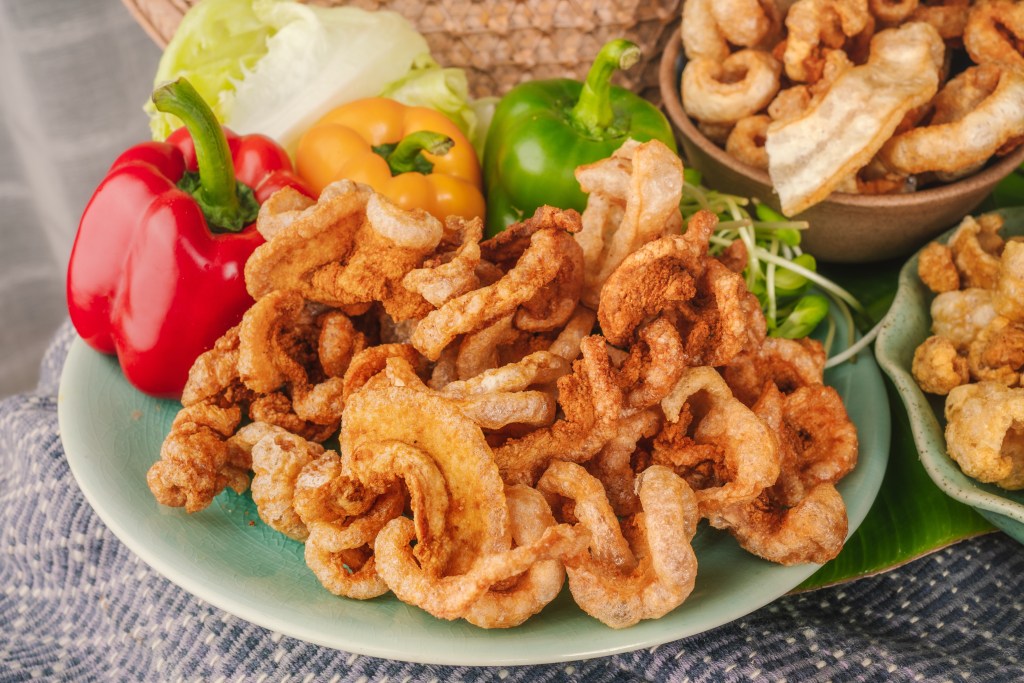Are pork rinds healthy? While often dismissed as junk food, pork rinds can actually be a valuable addition to a Healthy Keto® diet–if you choose the right kind.
These crispy, deep-fried pieces of pig skin are completely carb-free, rich in heart-healthy fats, and an excellent source of collagen. When made without artificial ingredients or processed oils, pork rinds are not only keto-approved but surprisingly nutrient-dense.
Discover three key reasons why you should eat pork rinds on keto and how to use them in Healthy Keto low-carb recipes.
Are pork rinds good for you?
Pork rinds, or pork scratchings, are made from rendered pig skin that has been boiled, dehydrated, and deep-fried, resulting in a puffed and crispy texture.
Because pork rinds are carb-free and have an excellent fat-to-protein ratio, pork rinds are perfect for keto diets and work well in many low-carb recipes.
Although pork rinds don’t have significant amounts of beneficial vitamins, they are a rich source of heart-healthy monounsaturated fats, saturated fat, collagen, and selenium.
Eating pork rinds is healthier than snacking on potato chips and other processed snack foods high in carbs, trans fats, and artificial ingredients.
However, most pork rind products are ultra-processed and high in sodium or monosodium glutamate (MSG), a food additive commonly used in fast food and junk foods to enhance flavor.
MSG intake is linked to health problems, including migraines, high blood pressure, headaches, and chronic fatigue.
To enjoy pork rinds as part of a healthy and nutritious diet, choose organic products that are minimally processed, MSG-free, low in sodium, and contain no artificial flavoring or preservatives.
Watch the video below to learn how to select the best quality pork rinds on a Healthy Keto diet.
Three reasons to have pork rinds on keto
Pork rinds are a surprisingly keto-friendly choice. They’re naturally free of carbohydrates, rich in protein, and a concentrated source of healthy fats, making them an excellent fit for the Healthy Keto@ lifestyle.
Here are three reasons why pork rinds can be a valuable addition to your keto meals.
1. Rich source of healthy fats
Pork rind fat is rich in oleic acid, the same monounsaturated fatty acid found in olive oil and avocados–foods well known for supporting cardiovascular health.
Oleic acid helps raise high-density lipoprotein (HDL), commonly known as good cholesterol, and helps lower low-density lipoprotein (LDL), known as bad cholesterol. It also supports a balanced inflammatory response by influencing antioxidant activity and gene expression.
Research published in Nutrients highlights that oleic acid plays a key role in supporting immune function, modulating inflammation, and promoting vascular health through multiple cellular mechanisms.1
In addition, oleic acid has been shown to help lower C-reactive protein (CRP) levels, a substance produced in the liver in response to inflammation.
Maintaining healthy CRP levels is associated with a lower risk of chronic inflammatory conditions, including heart disease, Alzheimer’s disease, and asthma.
2. A natural source of collagen
Protein is an essential macronutrient needed for countless body functions, from muscle development to cellular repair.
“Pork rinds are an excellent source of collagen, an essential structural protein that contributes to healthier bone, joints, and connective tissues,” explains Dr. Berg. “Pork rinds are a surprisingly rich, natural source of collagen.”
Increasing dietary collagen intake has also been associated with improved skin texture and reduced visible signs of aging.
A study published in the Korean Journal of Community Nutrition found that collagen derived from pork skin significantly increased serum collagen levels and supported skin health in middle-aged women who consumed it daily for 12 weeks.2
3. Supports weight loss
Pork rinds are naturally carb-free, making them keto-approved and a healthy snack alternative to potato chips, popcorn, or crackers.
Unlike high-carb foods that spike blood sugar and trigger insulin production, pork rinds provide protein and fat without disrupting ketosis.
Maintaining low insulin levels is essential for fat burning. When insulin remains balanced, the body is more likely to tap into stored fat for fuel, which supports weight loss and helps maintain a healthy waistline.

How to use pork rinds in keto recipes
Pork rinds are a popular ingredient on the ketogenic diet thanks to their crunchy texture and zero-carb profile. While they’re often considered a snack, frequent snacking, even on keto-friendly foods, can still contribute to weight gain.
Pork rinds’ real value lies in how they can enhance keto meals as a flavorful, low-carb substitute.
One of the most common uses for pork rinds is as a breadcrumb replacement. Crushed pork rinds can be used to coat meats, fish, or vegetables, offering a crisp, golden finish without added carbs.
For example, combining crushed pork rinds with grated Parmesan creates a delicious crust for pork chops or chicken. If you love pork chops, try these delicious Pork Rind and Parmesan Crusted Pork Chops.
Pork rinds also work well as a topping for salads, soups, and stews, adding texture and depth without interfering with your carb goals. Their crispness makes them ideal for dishes that need a satisfying crunch, such as keto casseroles or vegetable bakes.
You can even use pork rinds as a base for creative recipes. Crushed and baked with cheese, they form a sturdy foundation for low-carb pizza. They can also stand in for tortilla chips in Keto Pork Rind Nachos.
When using pork rinds in recipes, choose minimally processed options with no artificial additives. For optimal freshness and quality, consider making your own pork rinds at home–they can be stored in an airtight container in the refrigerator for up to one week.

Key takeaways
Are pork rinds healthy? When sourced and prepared properly, pork rinds are a surprisingly nutritious option for those following a Healthy Keto® lifestyle.
Pork rinds are naturally carb-free, rich in monounsaturated fats like oleic acid, and an excellent source of collagen to support skin, joint, and connective tissue health. Their crunchy texture makes them a smart substitute for breadcrumbs, tortilla chips, or croutons in keto recipes.
Many store-bought pork rinds are highly processed foods containing potentially harmful artificial flavors, unhealthy oils, and synthetic MSG. Choose minimally processed pork rinds with clean ingredients and no additives to support your health goals.
FAQ
1. What are pork rinds?
Pork rinds are made by baking or deep-frying pork skins. To achieve their distinct, crispy, puffed texture, the skins are typically boiled first, and any excess fat is scraped away.
2. Are pork rinds healthy to eat?
Yes, you can enjoy pork rinds as part of a healthy and nutritious diet.
Pork rinds are a rich source of healthy fats, including monounsaturated fat, saturated fat, and oleic acid. Oleic acid is the same fatty acid found in heart-healthy olive oil and linked to healthy cholesterol levels and reduced inflammation.
3. Can I have pork rinds every day?
You can add moderate amounts of pork rinds to your recipes daily. However, remember that pork rinds are energy-dense, and eating too many can lead to unwanted weight gain.
4. How many carbs are in pork rinds?
Pork rinds contain zero grams of carbohydrates.
5. Are pork rinds keto-friendly?
Pork rinds are perfect for keto. They are carb-free and have an excellent fat-to-protein ratio.
Incorporating pork rinds into your keto recipes is a great way to add texture and crunch. They are also excellent alternatives to potato chips, tortilla chips, croutons, and bread crumbs.
6. Can I use pork rinds as breading?
Yes, crushed pork rinds are fantastic for breading meat, fish, poultry, or even veggies.
7. Are pork rinds bad for cholesterol?
While pork rinds contain some dietary cholesterol, current research shows that cholesterol in food has little effect on blood cholesterol levels for most people.
The outdated belief that dietary cholesterol raises heart disease risk has been widely debunked. In fact, pork rinds contain oleic acid, which helps support healthy cholesterol balance.







